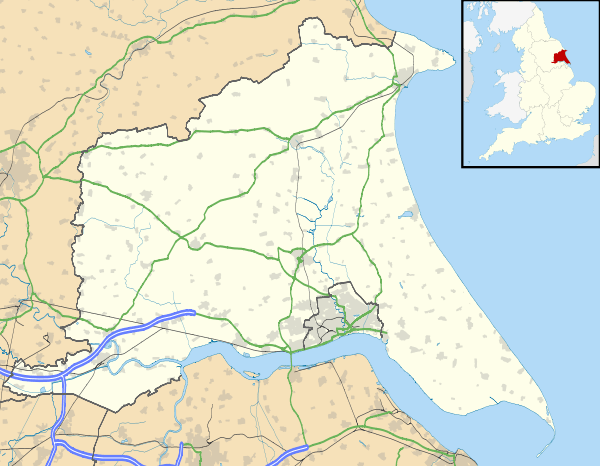Aughton, East Riding of Yorkshire
Coordinates: 53°50′21″N 0°55′44″W / 53.839136°N 0.928960°W
Aughton is a village in the East Riding of Yorkshire, England. It is situated approximately 7 miles (11 km) north-west of the market town of Howden and 9 miles (14 km) south-west of the market town of Pocklington. It lies west of the B1228 road and east of the River Derwent.
Together with Ellerton it forms the civil parish of Ellerton and Aughton.
All Saints Church



All Saints Church, Aughton is located at the far end of the village and overlooks vast expanses of the floodplains of the River Derwent. Tucked away in the village, it can only be accessed on foot through a small gate and field adjacent to Aughton Hall. An historic church, famous for its association with Robert Aske, leader of the insurgents in the Pilgrimage of Grace, October 1536. Aske was executed for treason on 12 July 1537.[1] The church displays a mixture of architectural designs as it has been altered throughout the years, but is noted especially for its Norman arch between the chancel and nave. On the chancel floor a well-preserved ancient brass of a knight in 15th century plate armour and his lady can be found, although much of the lady is now missing. Standing in the churchyard and looking up at the tower, (which was rebuilt by Christopher Aske sometime after 1536), a shield with six quarterings can be seen engraved on the outside wall, now badly weathered but it offers the following inscription in old French text: "Christofer le second filz de Robert Ask chr oblier ne doy, Ao Di 1536." This is literally translated as: "Christopher, the second son of Robert Aske, chevalier, ought not to forget the year of our Lord 1536." Also on the tower is a benchmark of the time and carved, in sunk relief, a newt or salamander otherwise known in Old English as an Ask.
The church was designated in 1966 as a Grade I listed building and is now recorded in the National Heritage List for England, maintained by Historic England.[2]
To the north of the church are the surviving earthworks, now restored, of a motte-and-bailey castle, that has been scheduled under the Ancient Monuments and Archaeological Areas Act 1979 as an ancient monument.[3]
References
- ↑ "1537: Robert Aske, for the Pilgrimage of Grace". ExecutedToday.com. Retrieved 11 August 2009.
- ↑ Historic England. "Church of All Saints (1346742)". National Heritage List for England. Retrieved 12 August 2013.
- ↑ Historic England. "Motte and bailey castle, fishpond and moated site north and east of Aughton church (1007973)". National Heritage List for England. Retrieved 18 February 2015.
Notes
- Gazetteer — A–Z of Towns Villages and Hamlets. East Riding of Yorkshire Council. 2006. p. 3.
External links
| Wikimedia Commons has media related to Aughton. |
- Historic England. "Details from image database (165263)". Images of England.
- Aughton in the Domesday Book
- The Aughton One-Place Study provides the history of the parish
